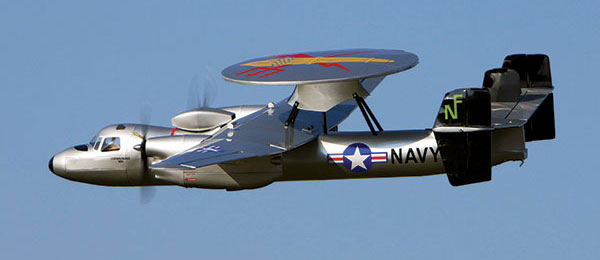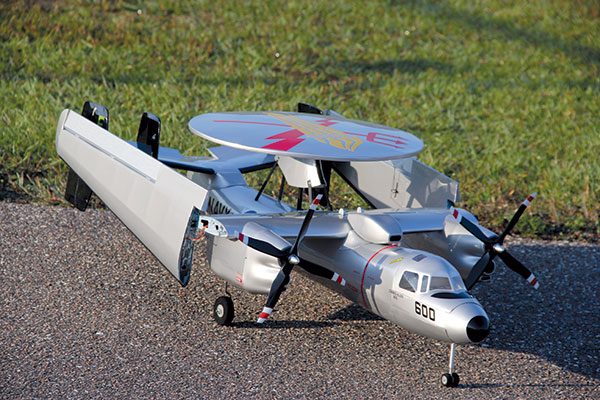Maxford USA E-2C Hawkeye EP ARF

Written by Andrew Griffith A model as enjoyable as it is unique Abridged product review Photos by the author Read the full product review in the February 2017 issue of Model Aviation.
Bonus video
Specifications
Model type: Semiscale ARF Skill level: Intermediate to advanced Wingspan: 71 inches; 27 inches with the wings folded Wing area: 755 square inches Wing loading: 26.3 ounces per square foot Wing cube loading: 11.5 Airfoil: Semisymmetrical Length: 50 inches Weight: 8 pounds, 10 ounces Power system: Twin electric motors Radio: Full-range, four-channel minimum; five channels required for optional retracts Construction: Built-up balsa and light plywood Covering/finish: UltraCote or similar with painted plastic trim parts Street price: $309.99Test-model details
Motor used: Two Turnigy D3548/4 1,100 Kv motors with Turnigy Plush 60-amp ESC Battery: E-flite 4S 4,000 mAh LiPo Propeller: Two 11 x 7 four-blade Radio system: Spektrum DX-18G2; AR9020 DSMX receiver; Hitec HS-55 servos Ready-to-fly weight: 8 pounds, 10 ounces Flight duration: 4 minutesPluses
• Unusual and seldom-modeled subject immediately commands attention. • Unique folding-wing system duplicating the full-scale aircraft makes for easy transportation and storage. • Scalelike flight performance. • Excellent scale looks in flight.Minuses
• The decals aren’t sufficiently opaque and look washed out on the dark sections of covering. • The forward landing gear mounting area showed stress cracks after only four landings and needed some reinforcement.Abridged product review
During my naval career, I was fortunate to be able to qualify as a plane captain on three aircraft: the P-3 Orion, the SH-60 Seahawk, and the E-2 Hawkeye. With that in mind, walking the aisles of the 2016 AMA Expo in Ontario, California, I stopped in my tracks walking past the Maxford USA booth when I saw a model of an E-2 Hawkeye! Maxford USA likes to bring unique and rarely modeled aircraft to the market. This is the only available kit for the E-2 Hawkeye of which I am aware. The twin engines and unusual tail are enough to make this model unique, and that is without the large radome for the APS-139 search radar perched on top of the fuselage. The proliferation of electric power systems has made all manner of unusual scale modeling subjects practical, but none more so than with multiple engine models such as the E-2. I remember owning a Pica Dualist several years ago. With glow-powered engines, getting two fueled, fired up, and running well enough to go flying was often an exercise in head banging. After the model attained flight, the ever-present danger of one of the motors flaming out made me a nervous wreck. Although not perfect, the high reliability of an electric power system takes much of the stress out of flying multiengine models. I was attracted to the Hawkeye as soon as I saw it and was excited to find out that I would be reviewing a model of a full-scale airplane that I had spent so much time working around in the Navy.
With its top-mounted radar antenna and unique tail feathers, the E-2C Hawkeye presents a unique profile that people stopped to watch each time it flew.
Construction
You need to make a couple of decisions before you get started. The most obvious is the power system. The other is whether you want to go with the supplied, fixed landing gear or the optional retractable landing gear. I couldn’t bring myself to settle for an airplane like this with fixed gear, so I ordered the optional retracts, as well as the four-blade scale propellers. Construction followed the sequence presented on the video starting with the tail feathers, which are unusual because the Hawkeye has twin rudders and two additional vertical stabilizers. There’s a lot going on back there, so dry-fit and check everything before you start dispensing glue. All of the Hawkeye’s control surfaces use CA hinges. I installed them with thin Zap CA. Assembling the center section is time-consuming and you should be proficient in soldering or enlist someone who is. Another point to remember is that when you have a multiengine model and both speed controllers are equipped with a BEC, you need to ensure that only one ESC is providing power to the receiver. I used a needle to lift the retainer and removed the center wire from the number two (right wing) speed controller servo plug. That left the ground and signal wire active and I taped back the positive wire. If the ESC is needed for a different project in the future, it’s simply a matter of snapping the power lead back into the servo plug. Reversing a brushless motor is simply a matter of swapping any two of the three wires, so the best way to keep the motor wires straight is to use one color of wire on each side. If the motor rotates backward, you simply swap two black wires or two red wires. Zip ties or heat-shrink material go a long way to keep the many wires running through the wing under control (especially if you have retracts). I used motors that are the same size as the recommended ones and everything in the nacelles fit quite well. As with each metal-to-metal fastener, the motors were installed using Z-42 threadlocker. After the nacelles were installed and the wires routed, I gave considerable thought to joining the front of the fuselage to the midsection. With the weight of the batteries up front and the relatively long moment, I wanted a good joint. I decided to use Epo-Grip Model Matrix. Epo-Grip is a pastelike epoxy and the Model Matrix product has milled fiberglass for extra strength. The full-scale Hawkeye has folding wings to minimize the valuable real estate that it takes up on the flight deck or hangar deck of an aircraft carrier. An unusual feature of the Maxford E-2 is that it closely duplicates the folding wing.
The wings on the full-scale E-2 fold to save precious real estate in the cramped quarters of an aircraft carrier. The Maxford E-2 faithfully replicates that and allows the model to be stored and transported with the wings installed. They can be folded and locked in place for flight in only a few minutes.
Assembling the wings is simply a matter of installing the aileron servos in an identical fashion as the rudder and elevator servos and gluing the hinges with thin Zap CA. The wing sweep mechanism installation is well detailed in the video, and if you carefully follow it, you won’t have any problems. The decals were applied using a few drops of dishwashing detergent dissolved in a bowl of warm water. Clean your hands with dish soap to remove any oils from your skin that will interfere with the adhesive on the decals. Soak the decal, float it into place, and squeegee the water out with an old credit card or your finger wrapped with a paper towel. The control throws were set up per the manual and I added 30% exponential to all of the control surfaces. After powering up, the gear switch needs to be cycled with the model held off of the table before it will arm. The instruction video says to wait 10 seconds, but mine doesn’t arm unless I pick it up and flip the switch once. The building time is longer than many ARF kits because of the amount of soldering required to wire up two motors and ESCs. I easily put 10 to 12 solid hours into constructing the Hawkeye, with two of those being the decal application. Although anyone with ARF building experience can follow the video and build this model, it isn’t a quick build.










1 comments
Maxford E2C
Add new comment